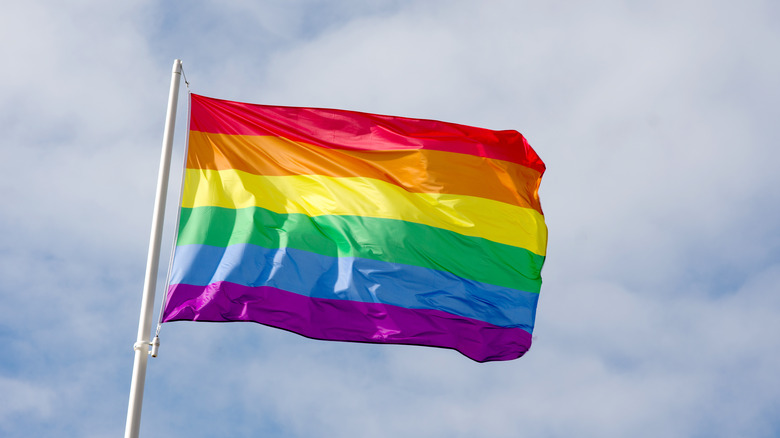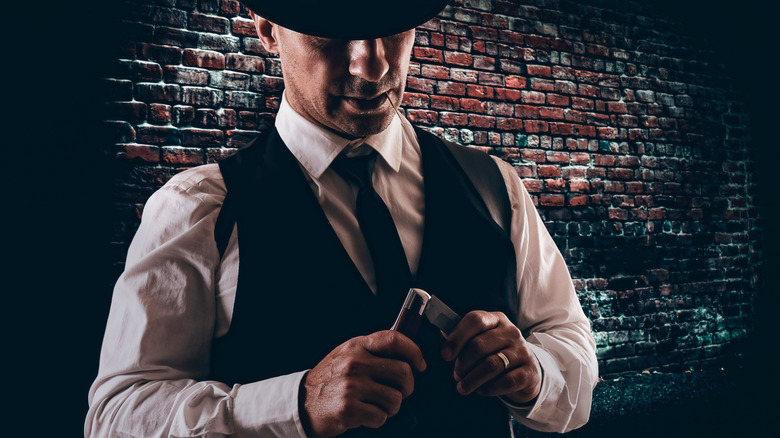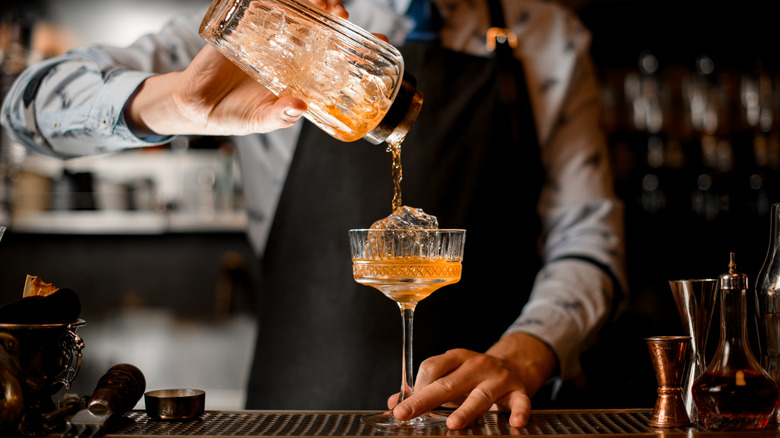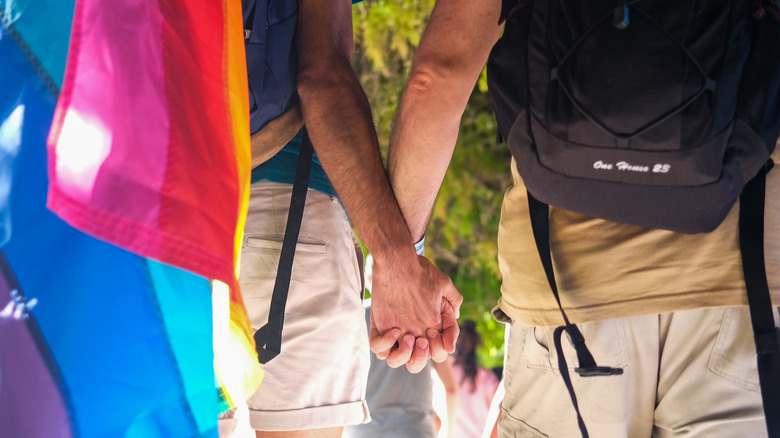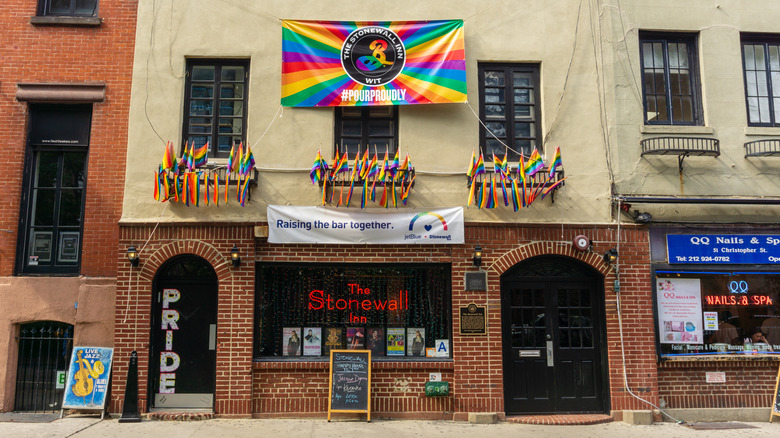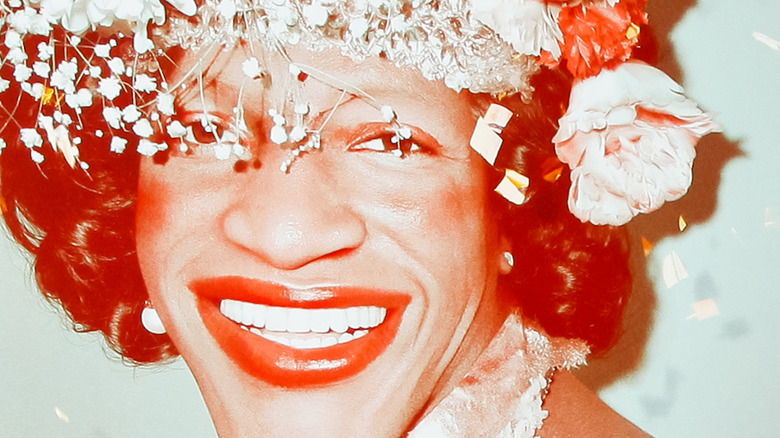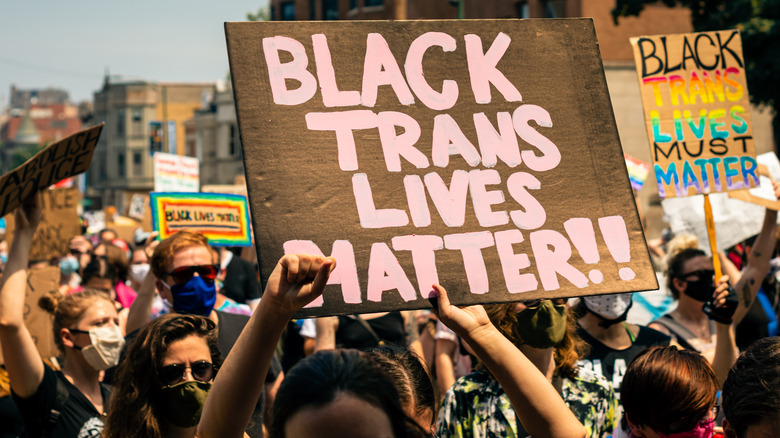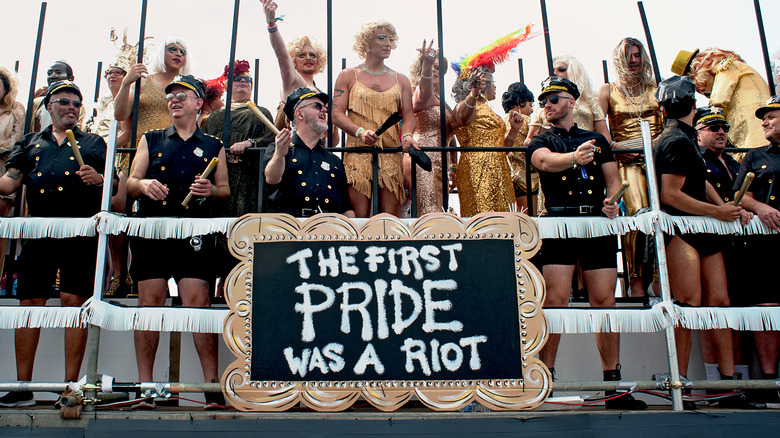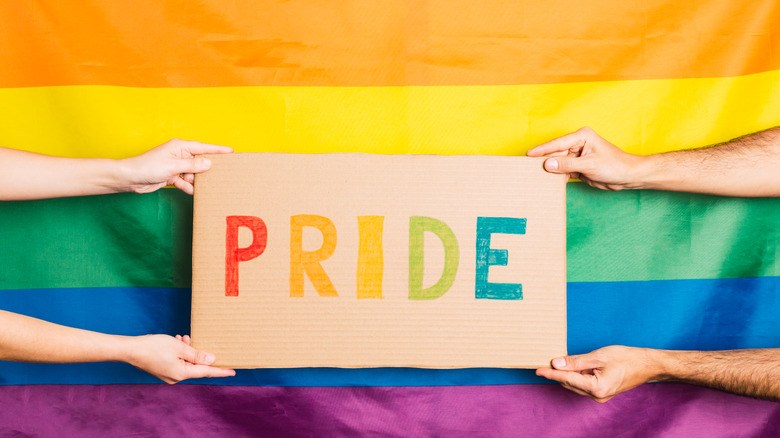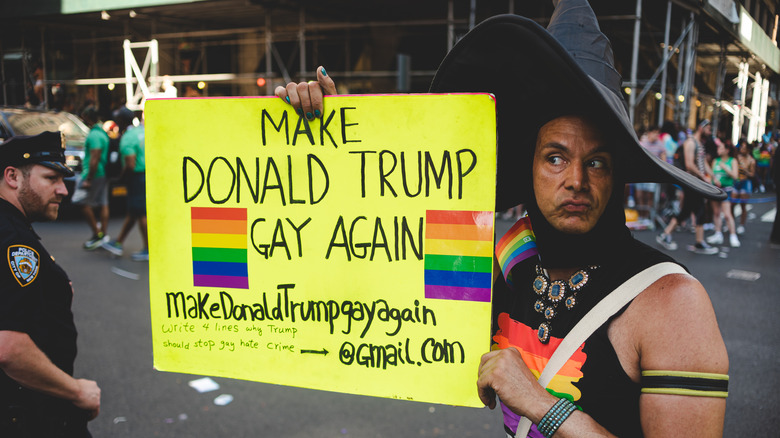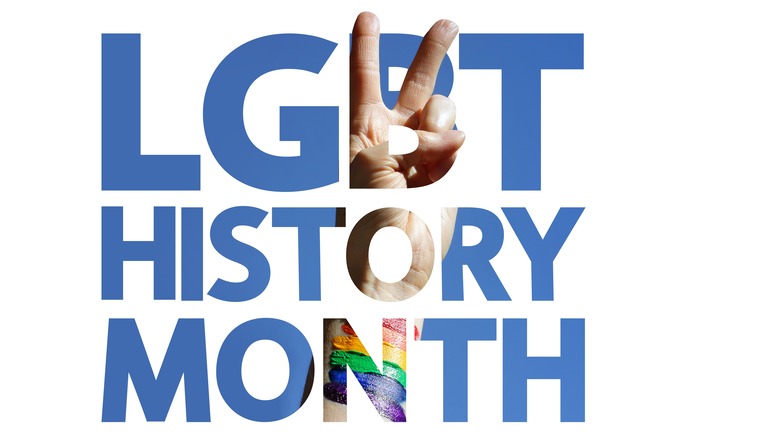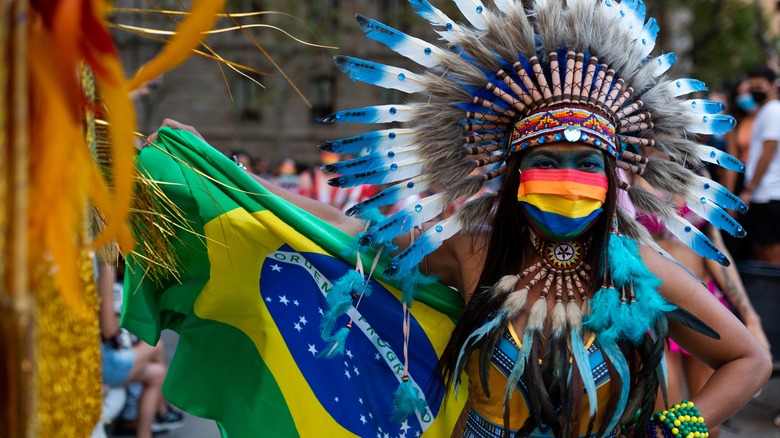The Untold Truth Of Pride Month
Typically in June, Pride Marches take over the streets of cities around the world to highlight the LGBTQ+ community and their struggles for equality. Sometimes the event lasts for the whole month, on other occasions a bit less, but it always includes colorful festivities and musical events, as well as workshops and other educational activities.
But the history of Pride Marches is not as well-known as the colorful flag commemorating the fight and struggle of many activists, community members, and other individuals. It all started with hatred and repression toward the early LGBTQ+ community members who rebelled through a series of riots, protests, and other means. In the beginning, the fight lay on the shoulders of the most marginalized — poor, trans people of color, who were targeted by the police. Only after several high-profile resistance events — such as the Annual Reminders in Philadelphia, "Gay-Sip Ins," and Stonewall Inn riots in New York City — did the community start to organize similarly to other Civil Rights Movement groups, strategically and intentionally (via History).
The first Gay Pride Marches were organized on the anniversary of the Stonewall Inn riots, but there is still much history left to be unpacked. While the LGBTQ+ community is proud of its diversity, there are many internal tensions, accusations of whitewashing, and silencing of the voices that might not fit the popular narrative of well-educated activists, as per CNN. Here is the untold truth of Pride Month.
When gay dancing was still forbidden, the Mafia took over bars
While homosexuality is common among different animal species and was often practiced in ancient cultures — such as ancient Greece — through time, monotheistic religious influences all over the world have managed to exclude it from society as something immoral and abnormal. While the gay culture thrived in the 1920s, it was all over soon. The repression that succeeded the short period of freedom was brutal, as police forces and politicians like Joseph McCarthy tried to crack down on any homosexual activity in the USA during the 1950s and 1960s, making gay bars (or even gay dancing) illegal. They often arrested people on the basis of cross-dressing, referring to the "three article law," which demanded at least three pieces of adequate attire, masculine for men and feminine for women. The rule was never actually legislated and was a legacy of a law that targeted farmers who dressed as Native Americans to avoid taxation (per History).
The Mafia seized the opportunity for profits hidden in the pockets of gay people, taking over the New York gay bar scene that was evolving in West Manhattan. Tony Lauria or "Fat Tony" owned Stonewall Inn since 1966 but sustained it with as little effort as possible (via History). Regardless of its state, the bar became a safe haven for the gay community, who mostly wanted peace from violence and the police. The Genovese family made sure that any raids which did happen were tipped off, taking place in the slow afternoon hours.
At some point during the repression, gay activists organized Sip-Ins
When the World's Fair event took place in New York City in 1964, the city administration worked hard to "clean up" the city, which led to several shutdowns of gay bars as they were seen as disorderly (per History). Gay activists fought back, taking inspiration from the Civil Rights Movement and their peaceful sit-in protests — not engaging in any kind of violence, activists visited racially segregated spaces and demanded equal service for everyone.
Members of the LGBTQ+ community organized "Sip-Ins," visits to ordinary bars with the intention to be served like everyone else. Craig Rodwell — the activist who organized Annual Reminders — Randy Wicker, and Dick Leitsch, head of the New York Mattachine Society, entered the premises, casually revealed they were gay, and ordered a drink. But they notified some media before their first Sip-In, so the protests failed, as they were served without any problems. It was only in the third bar, Julius, that the Sip-In succeeded, and when the activists were denied the refreshments, they filed a discrimination complaint to State Liquor Authority (with the help of the American Civil Liberty Union). The State Liquor Authority rejected the claim at first but changed its mind after the Commission on Human Rights intervened. Bars should not discriminate on sexuality, declared the State Liquor Authority, and the bar scene did warm up toward gay people — at least a bit. Today, Julius still exists, claiming to be one of the oldest gay bars in New York.
Annual Reminders did not gain much traction until some activists held their hands
The LGBTQ+ community frequently organized events that would bring attention to the discrimination they experienced, although the initial acts were much smaller than today's Gay Pride Marches. According to Philadelphia Encyclopaedia, the protest outside Philadelphia Independence Hall on July 4, 1965, is documented as one of the first organized demonstrations in support of gay rights in the USA (but not the first, as there was one similar event two months prior in Washington). Thirty-nine individuals gathered at the protest organized by Frank Kameny, Barbara Gittings and the East Coast Homophile Organization, dressed in full business attire — proving they can be, just as everyone else, employable and "normal." The protesters gathered and demanded changes in the law on the basis of their constitutional right of "Pursuit of Happiness." As explained by Philadelphia Encyclopaedia, these Annual Reminders took place for several years after 1965 until July 1969.
The organizers, Kameny, Gittings, and Kay Tobin Lahusen, thought the protesters should look as "normal" as they could to prove they could be equally productive members of society. But Craig Rodwell, one of the organizers, disagreed when Kameny demanded that a lesbian couple should stop holding hands — a much younger Rodwell got angry, calling Kameny an Auntie Tom and encouraging some other protesters to hold hands, per the podcast "Making Gay History." Hand holding between same-sex couples was caught on camera, so the media grabbed the story. But some vile reports of the event aside, it succeeded in generating publicity (via NBC News).
50 years after the Stonewall Riots, the NYPD apologized
Another raid took place in Greenwich Village in New York on a steamy summer night on Tuesday, June 24, 1969, when police forces confiscated illegal alcohol and arrested some members of bar staff (per History). They returned on Friday the same week to finish their work and close down the bar for good but were met with resistance. The locals started to gather around the bar, and it was only in the early hours of Saturday morning, June 28, when riots fully blew up. Objects were thrown at the police, which led to the police barricading themselves inside the Stonewall Inn. The Stonewall Inn reopened again on Saturday evening for the night after the riots. More and more members of the community came to the scene, as well as another police squad, which attacked people physically and with tear gas.
The Stonewall riots became the turning point for gay activism, as the community started to organize, spreading information about the attack and discussing possible options to address the issue of violence and repression. The first Pride Marches took place on the anniversary of the riots, commemorating the historical turn of the tide. In 2019, the NYPD finally apologized for the violent raid of the Stonewall Inn (via NBC News): "What happened should not have happened," stated NYPD Commissioner James P. O'Neill. "The actions taken by the NYPD were wrong, plain, and simple. The actions and the laws were discriminatory and oppressive, and for that, I apologize."
There is a lot of whitewashing included in the Stonewall riots history
The Stonewall riots weren't the first case of LGBTQ+ rebellion, and neither were the Annual Reminders. According to Refinery29, there were the Cooper's Donut Riots in 1959, Compton's Cafeteria Riot in 1966, and the Black Cat Riot of 1967, all with a strong racial component, as the majority of those involved weren't white.
The spark that led to the Stonewall riots that night was created by Black, queer, and trans people — a part of history that is often omitted. As per Morven Loh for Fumble, Marsha P. Johnson and Sylvia Rivera – trans activists of color — were the leading personalities in the movement, as were other queer trans and non-binary people of color, but even a community as diverse as the LGBTQ+ is not immune to racism. After the Stonewall riots, several gay activist groups were organized on the blueprint of the Black Panther Party, and there was even some mutual support between the two groups. But this is the part of history that is not mentioned or studied often.
The film Stonewall (2015) by Roland Emmerich is a great example: It tells the story of these historical events but through the eyes of a fabricated character named Danny Winters. Danny is white, blond, and blue-eyed and embarks on his journey after his small-town local community in Indiana rejects his homosexuality. While this story is well worth telling, many questioned whether this movie is about teenage homelessness or the history of Stonewall Inn — a petition was created, attacking Emmerich for "whitewashing" the real events (via CNN).
Who is the real Mother of Pride?
Radical activist Brenda Howard stepped to the occasion just one month after the Stonewall Riots, when she organized the Stonewall anniversary rally, Elyssa Goodman explains for Them. She used her skills again a year after when she and Gay Pride Week committee organized Christopher Street Liberation Day Parade and Gay Pride Week, which later turned into the famous New York City Pride March. She founded New York Area Bisexual Network (NYABN) and was a part of the Gay Liberation Front and Gay Activists' Alliance while campaigning for many other causes — one of them was the inclusion of bisexuals in the LGBTQ community. Officially known as the Mother of Pride, she became almost a legend. But it has to be noted that while Howard was bisexual and a feminist, she was also educated, white, and cis, which could be the reason behind her fame.
The first riots, as the one in Compton's Cafeteria, grew out of frustration as the police frequently arrested people who cross-dressed (remember the three-part clothing rule), not for being gay. The involvement and massive contribution of the trans community were "almost lost to history", as per CNN, until scholar Susan Stryker found the information in New York City archives. The Compton's Cafeteria riots were led by drag queens. As already mentioned, Marsha P. Johnson and Sylvia Rivera led the resistance on the ground from day one, representing the trans community, who was the first to rebel — so why did it take Stryker to point that out? As per sociologist Joss Greene, this could be because even the diverse LGBTQ+ community has ideas of who fits and who doesn't.
It started without all that glitter
As the resistance movement grew out of riots, there wasn't much celebration at the beginning (via History). The riots were a mirror of the violent forces trying to shut down basic human rights, and many who were involved paid the price of physical violence, verbal abuse, and legal oppression.
Annual Reminders were focused on proving the "normality" of the community, intentionally hiding the colors and the flair. When Craig Rodwell, Fred Sargeant, Ellen Brody, and Linda Rhodes suggested the idea of the first Pride March in New York, held a year after the Stonewall Riots, they also proposed a radical concept for the march — it should happen without any dress or age regulations. The New York Christopher Street Liberation Day March of 1970 was a mixture of a demonstration and festivities, but far from the party known today. There was no music, floats, or other carnival-like features — just thousands of people marching with pride.
The week-long event in Chicago did include a Gay Dance and educational activities but ended with a march under the slogan "Gay Power." The Los Angeles section marched through Hollywood Boulevard but also had a serious demonstration, similar to the San Francisco one, where the community marched on Polk Street, ending the event with a "Gay-in" in Golden Gate Park. It was only throughout the years — when Pride Marches became bigger and the rights of LGBTQ+ people became a real legal category — that more glitter and partying became staples of the events.
Gay pride was a term coined by the pie throwing activist ... or was it?
Thom Higgins turned into a gay activist after he was suspended from his studies at the University of North Dakota for running an underground newspaper, Snow Job, in 1968 (via Chester Fritz Library). He participated in the Church of the Chosen People, the organization that campaigned for a shifting perspective on homosexuality, seeing it as "healthy and fulfilling personal option." As reported by Smithsonian Magazine, he became famous after he threw a pie in the face of the former beauty queen Anita Bryant, the lady who led public anti-gay rhetoric, calling homosexuals "human garbage." Higgins died young but is referred to in several sources as the person who coined the concept of gay pride (via SignLink).
But according to The Allusionist, this is disputed by living activist Craig Schoonmaker, who said in 2015 he was the one who "authorized" the term "pride" for "gay pride" because "somebody had to come up with it!" While debating the options on how to name the events commemorating the Stonewall riots with the event committee, Schoonmaker claims he wasn't keen on the term "gay power" since not many people had power at the time, but everyone can have pride.
When Pride Month becomes Great Outdoors Month
In 1999, Bill Clinton proclaimed June 1999 as Gay and Lesbian Pride Month, where he encouraged all Americans to celebrate diversity through events, parades, and other activities. In the proclamation, Clinton emphasized the 30th anniversary of the Stonewall Uprising and the "birth of the modern gay and lesbian civil rights movement" (via The American Presidency Project). As a part of the anniversary, Stonewall Inn and the streets around it were added to the National Register of Historic Places.
According to the Battle Creek Pride organization, when Clinton was followed by George W. Bush as a president, the latter did not recognize the Pride Month for two mandates in a row, showing how fragile these initiatives actually are. Barack Obama endorsed it, as did Joe Biden. Elsewhere, Donald Trump became the first Republican president who at least publicly recognized Pride Month over his Twitter account with a series of tweets (which are deleted today, along with his account). He never did it officially — he proclaimed June to be "National Homeownership Month, Great Outdoors Month, and Caribbean-American Heritage Month" instead (via Snopes). His administration also proposed legislation that would allow medical workers to refuse treatment of trans people and another to make it possible for homeless trans people to be legally rejected from homeless shelters.
Pride Month is not the same as LGBT History Month
One should not confuse Pride Month and LGBT History Month, as the first commemorates rebellion and is focused on celebration, while the second is more educational in nature. LGBT History Month is in October, in the same month as National Coming Out Day on October 11 and the anniversary of the gay and lesbian march on Washington in 1979 (via the University of Central Florida). It was Rodney Wilson, a high school teacher from Missouri, who got the idea for LGBT History Month. One year later, in 1995, it was officially recognized by the General Assembly of the National Education Association and implemented with other commemorative months. LGBT History Month also focuses on highlighting the achievements of LGBTQ+ individuals who lead by example and continue to fight for a better, less violent world.
There are several important days in October related to the LGBTQ+ community, besides the National Coming Out Day. On October 20 is Spirit Day, when some people wear purple to support LGBTQ+ youth, while Ally Week supports alliances among those who condemn LGBTQ+ bullying. October also commemorates October 12, 1998, the day when Matthew Shepard died due to hate crime, which led to Matthew Shepard and James Byrd Jr. Hate Crimes Prevention Act in 2009.
Pride Month around the world
While Pride Month started in the United States, it soon spread across more than 50 countries around the world, according to Slacker. Marche des Fiertés LGBT in Paris, France, is one of the biggest in the world, and it's marking its 41st anniversary in 2022. The grandest and probably the flashiest one must be the one in São Paulo, Brazil, documented as the "largest pride" parade by the Guinness World Record organization, attracting over 3 million people from all around the world. A bit further up north, Mexico City's Pride Parade is also known for its exceptional vibe, as 1 million supporters gather each year and celebrate pride. There are two massive marches in Berlin, Germany, and London, U.K., while people in Amsterdam, Netherlands celebrate Pride Month in a unique way — traveling through the city on canal boats.
Several countries only joined Pride Month in recent years, which is a massive step for LGBTQ+ communities in places where their fight is still much needed. South Korea organized its first Pride March in 2019 in Seoul, while the activists in Bucharest, Romania officially celebrated pride since 2000. The one in Romania is more serious and less celebratory, as the country is still working its way toward a society more focused on human rights. Ukraine organized its first pride in 2018 in Kiev, managing to sustain the parade for 20 minutes and ending without being interrupted by violence for the first time in the country's history.
